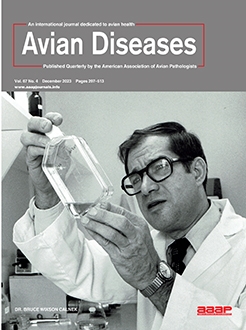Avian influenza (AI) is a highly contagious disease that can be transmitted to naïve birds through fomites. The survival of AI viruses (AIV) on nonporous and porous fomites also dictates how long the fomite can serve as a vehicle for virus transmission. AIVs are known to be inactivated by ozone and ultraviolet (UV) light. However, the combined effect of UV light and ozone in combating AIV on different fomites has not been investigated. This study was undertaken to determine AIV inactivation by a commercial device called the BioSec shoe sanitizing station. This device generates both ozone and UV light for 8 sec when activated. We evaluated this device against three different subtypes of AIVs applied on seven different fomites. In general, the device inactivated all three AIV subtypes loaded on all fomites but to varying degrees of inactivation. The percentage of virus reduction on nonporous fomites (98.6%–99.9%) was higher than on porous fomites (90.0%–99.5%). In conclusion, this new device has the potential to help reduce the risk of transmission of AIV.
Inactivación de cuatro subtipos del virus de la influenza A mediante un dispositivo comercial usando luz ultravioleta y ozono.
La influenza aviar (IA) es una enfermedad altamente contagiosa que puede transmitirse a aves susceptibles a través de fómites. La supervivencia de los virus de la influenza aviar en fómites porosos y no porosos también determina cuánto tiempo el fómite puede servir como vehículo para la transmisión del virus. Se sabe que los virus de influenza aviar son inactivados por el ozono y la luz ultravioleta (UV). Sin embargo, no se ha investigado el efecto combinado de la luz ultravioleta y el ozono para inactivar el virus de la influenza aviar en diferentes fómites. Este estudio se llevó a cabo para determinar la inactivación del virus de la influenza aviar mediante un dispositivo comercial llamado estación de desinfección de calzado BioSec. Este dispositivo genera ozono y luz ultravioleta durante 8 segundos cuando se activa. Se evaluó este dispositivo frente a cuatro subtipos diferentes del virus influenza aviar aplicados en siete fómites diferentes. En general, el dispositivo inactivó los cuatro subtipos de influenza aviar inoculados en todos los fómites, pero con distintos grados de inactivación. El porcentaje de reducción de virus en fómites no porosos (98.6%–99.9%) fue mayor que en fómites porosos (90.0%–99.5%). En conclusión, este nuevo dispositivo tiene el potencial de ayudar a reducir el riesgo de transmisión del virus de la influenza aviar.





